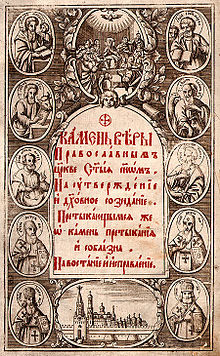The Rock of Faith, a.k.a. The Stone of Faith (Russian: Камень веры), is a major anti-Protestant treatise written by archbishop, Stefan Yavorsky in 1713–1715.[1] Its full title "The Stone of faith: for the sons of the holy Orthodox Church — for affirmation and spiritual creation; for those who stumble over a block of stumbling and temptation — for getting up and correcting", Church Slavonic: Камєнь вѣры: православнымъ цєрквы святыѧ сыномъ на утвєрждєнїє и духовноє созиданїє. Прєтыкающымсѧ жє ω камєнь прєтыканїѧ и соблазна. На востанїє и исправленїє. Later it was also published under the title, The Stone of Faith of the Orthodox Catholic Eastern Church, Russian: Камень веры православно-кафолическия восточныя Церкви...[1]

Peter the Great forbade its publication: at these times Russia needed to attract foreigners, and such work would be detrimental to this. It was published in 1728 under Peter II.[2]
An anonymous pamphlet that has eventually become known in historical works under the title, "Hammer on the Rock of Faith" (Молоток на „Камень веры“, Molotok na kamen very), a rebuttal of Yavorsky's treatise, appeared between 1732 and 1734.[3]
Summary
editThe Rock of Faith consists of twelve chapters that cover the following issues: the icons; the cross; the relics; the Eucharist; prayers to the saints; prayers for the departed; tradition; liturgy; fasting; good works; and punishment of heretics.[1]
References
edit- ^ a b c Adam Drozdek, "STEFAN IAVORSKII AND PROTESTANTISM"
- ^ Митрополит Стефан (Яворский) и книга «Камень веры», citing Anton Kartashev, Очерки по истории Русской Церкви, vol. II, 2006. p. 473
- ^ Grigoryev A.B. ЗАГАДКИ СОЧИНЕНИЯ «МОЛОТОК НА КНИГУ “КАМЕНЬ ВЕРЫ”» (contains a text of The Hammer..., in Russian, based on an 18th century manuscript from Russian archives)